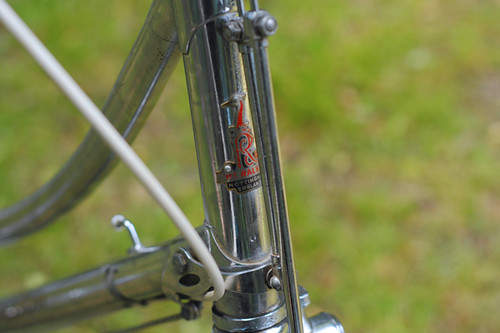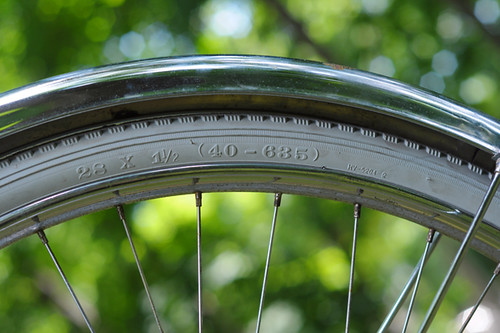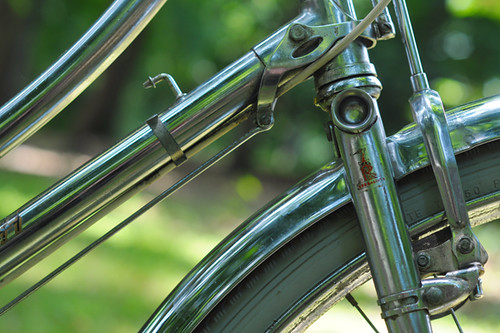 I took this photo from our kitchen window looking over to our neighbors house.
I took this photo from our kitchen window looking over to our neighbors house.Wednesday, July 10, 2013
Tuesday, July 9, 2013
Flower Vase

I don't know anything about this flower vase that mother had except that it says 'handpainted in Japan' on the bottom
Friday, July 5, 2013
Pea Island National Wildlife Refuge
 I've been counting down the days for something exciting-my dear friend Barb and her husband John coming to camp with us. We met them at the Pea Island Wildlife Refuge and wandered around for a short time. A very short time compared to how long we probably both would have stayed because the mosquitoes were out in killer force even with bug spray on. It is a beautiful refuge from what we did see and we saw a few birds while there.
I've been counting down the days for something exciting-my dear friend Barb and her husband John coming to camp with us. We met them at the Pea Island Wildlife Refuge and wandered around for a short time. A very short time compared to how long we probably both would have stayed because the mosquitoes were out in killer force even with bug spray on. It is a beautiful refuge from what we did see and we saw a few birds while there. Refuge Facts
Refuge Facts- Established: May 17, 1937.
- Size: 5,834 acres (land), 25,700 acres (Proclamation Boundary Waters).
- Located on the north end of Hatteras Island, a coastal barrier island and part of a chain of islands known as the Outer Banks.
- Approximately 13 miles long (north to south) and ranges from a quarter mile to 1 mile wide (from east to west).
- Location: 10 miles south of Nags Head, North Carolina on NC 12.
- Administered by Alligator River National Wildlife Refuge as a part of complex; Alligator River Manager supervises the Mackay Island, Currituck, and Pocosin Lakes National Wildlife Refuge Managers.
- The Comprehensive Conservation Management Plan for Pea Island National Wildlife Refuge is complete.
 Natural History
Natural History- Area was historically used for market waterfowl hunting, commercial fishing, farming, and
livestock operations. - Refuge is comprised of ocean beach, dunes, upland, fresh and brackish water ponds, salt flats, and salt marsh.
- Bird list boasts more than 365 species; wildlife list has 25 species of mammals, 24 species of reptiles, and 5 species (low number due to salt environment) of amphibians.
- Concentrations of ducks, geese, swans, wading birds, shore birds, raptors, neotropical migrants are seasonally abundant on refuge.
- Refuge has 1,000 acres of manageable waterfowl impoundments.
- Several shorebird nesting areas and wading bird rookeries are located on the refuge.
- Endangered and threatened species include: peregrine falcons, loggerhead sea turtles, and piping plovers.
 Refuge Objectives
Refuge Objectives- Provide nesting, resting, and wintering habitat for migratory birds, including the greater snow geese and other migratory waterfowl, shorebirds, wading birds, raptors, and neotropical migrants.
- Provide habitat and protection for endangered and threatened species.
- Provide opportunities for public enjoyment of wildlife and wildlands resources. Public use programs focus on interpretation, environmental education, wildlife observation, wildlife photography, and fishing.

Wednesday, July 3, 2013
Death Valley :: Scottys Castle
Be forewarned – this post is graphic intensive – lots of photos!
Thursday, March 8th - - Continuing on with today's excursion, it was only a few miles further north to Scotty's Castle. Walter Scott was a shyster. Using the lure of untold millions of dollars worth of gold in his mine, he duped wealthy business men into financing his imaginary mine – though they didn't know the mine really didn't exist! He eventually incurred the favor of a wealthy business man from Chicago. Albert Johnson, in poor health found another kind of wealth from the dry desert air and an escape from the busy life he led. He enjoyed Scotty's company and the tales he told, whether true or not.
In the early 1920s Mr. Johnson began construction of a vacation home – his wife didn't care much for camping and sleeping on the ground but she enjoyed being in the desert. Within a short time, the palatial house became known as “Scotty's Castle” and the Johnson's went along with it all, perhaps getting a great deal of pleasure in the ruse they were playing on friends and guests who visited the ranch and listened to the stories told by Scotty.
You can read more about the story behind Scotty's Castle on the Death Valley website. It's a fun and interesting story!

As you are driving in from the south, through pretty much barren land, nestled in a small valley at the end of Death Valley National Park there is a little oasis, likely the only potable water in that end of the valley, and nearby is the site upon which Mr. Johnson chose to build his little house.

The courtyard between the two buildings with the clock tower in the background.

Inscribed above the door is “Death Valley Ranch” which is the name the Johnson's gave the place.
The interior of the house is dimly lit, the windows are covered with the original draperies some of which were made of leather. The draperies are closed to block out the sunlight and help preserve the furnishings. Oddly enough, photographs are allowed to be taken inside – even with flash!

The main entry-room was impressive with its floor to ceiling fireplace spanning two floors. The second floor has a balcony that goes completely around the entry-room.

The tour guides dress in period costumes from the 1930s, which is when the Johnson's opened their home to tour groups to help pay for the upkeep of the ranch.

Decorative tiles over the kitchen sink.

The kitchen stove, with copper cooking utensils. The little white appliance on the left of the shelf above the stove is a toaster. Their vacation may have been in a remote area, but the Johnson's had the latest and most modern features.

A floor level view of that fireplace, taken from the kitchen doorway.

A corner fireplace in one of the guest rooms upstairs.

The music room. To the left was a long alcove with a player organ. As part of the tour, they turn it on and play one song. It was beautiful and quite loud.

The elaborate ceiling of the music room. The cables are part of the original construction, used to keep the walls from bulging outward.

A beautiful stained glass window in the west wall of the music room.

Looking up the spiral staircase that leads to the top of the tower, which can be seen on the right side of the photo below.

A front view of Scotty's Castle. The pool in front goes the entire length of the house, and more. The tour guide said it had never been filled with water. If you look closely you can see a cross on the hill above and behind the house. Scotty's grave is to the left of the cross, he died in 1954.

I was amused by the “old prospector” weather vane atop the front tower, probably depicting Scotty on one of his legendary mining expeditions.
Thursday, March 8th - - Continuing on with today's excursion, it was only a few miles further north to Scotty's Castle. Walter Scott was a shyster. Using the lure of untold millions of dollars worth of gold in his mine, he duped wealthy business men into financing his imaginary mine – though they didn't know the mine really didn't exist! He eventually incurred the favor of a wealthy business man from Chicago. Albert Johnson, in poor health found another kind of wealth from the dry desert air and an escape from the busy life he led. He enjoyed Scotty's company and the tales he told, whether true or not.
In the early 1920s Mr. Johnson began construction of a vacation home – his wife didn't care much for camping and sleeping on the ground but she enjoyed being in the desert. Within a short time, the palatial house became known as “Scotty's Castle” and the Johnson's went along with it all, perhaps getting a great deal of pleasure in the ruse they were playing on friends and guests who visited the ranch and listened to the stories told by Scotty.
You can read more about the story behind Scotty's Castle on the Death Valley website. It's a fun and interesting story!

As you are driving in from the south, through pretty much barren land, nestled in a small valley at the end of Death Valley National Park there is a little oasis, likely the only potable water in that end of the valley, and nearby is the site upon which Mr. Johnson chose to build his little house.

The courtyard between the two buildings with the clock tower in the background.

Inscribed above the door is “Death Valley Ranch” which is the name the Johnson's gave the place.
The interior of the house is dimly lit, the windows are covered with the original draperies some of which were made of leather. The draperies are closed to block out the sunlight and help preserve the furnishings. Oddly enough, photographs are allowed to be taken inside – even with flash!

The main entry-room was impressive with its floor to ceiling fireplace spanning two floors. The second floor has a balcony that goes completely around the entry-room.

The tour guides dress in period costumes from the 1930s, which is when the Johnson's opened their home to tour groups to help pay for the upkeep of the ranch.

Decorative tiles over the kitchen sink.

The kitchen stove, with copper cooking utensils. The little white appliance on the left of the shelf above the stove is a toaster. Their vacation may have been in a remote area, but the Johnson's had the latest and most modern features.

A floor level view of that fireplace, taken from the kitchen doorway.

A corner fireplace in one of the guest rooms upstairs.

The music room. To the left was a long alcove with a player organ. As part of the tour, they turn it on and play one song. It was beautiful and quite loud.

The elaborate ceiling of the music room. The cables are part of the original construction, used to keep the walls from bulging outward.

A beautiful stained glass window in the west wall of the music room.

Looking up the spiral staircase that leads to the top of the tower, which can be seen on the right side of the photo below.

A front view of Scotty's Castle. The pool in front goes the entire length of the house, and more. The tour guide said it had never been filled with water. If you look closely you can see a cross on the hill above and behind the house. Scotty's grave is to the left of the cross, he died in 1954.

I was amused by the “old prospector” weather vane atop the front tower, probably depicting Scotty on one of his legendary mining expeditions.
Tuesday, July 2, 2013
Monday, July 1, 2013
Not a Typical DL-1

Over the years I've been fortunate enough to befriend some very serious bicycle collectors. And I understand enough about how they operate to know it is unlikely that I will ever be one of them. I have a strong aversion to online auctions. I am unwilling to spend my weekends traveling across state lines to visit bike swaps and barn sales. Space is an issue. Andmost importantly, my tastes in bikes are too varied. But if there is one bicycle in which my interest has remained consistent, it is the Raleigh DL-1 Lady's Tourist.
I acquired my first one in - a run of the mill 1973 model in so-so condition - and "frankenbiked" it into a working city steed which I still ride today. The second Lady's Tourist was practically forced into my hands half a year later. The 1930s model was covered in surface rust and I did not want it. Where would I keep the filthy thing? But the gentleman who offered it insisted I was the rightful owner: "Take it. It is completely intact and that rust can be removed. You won't regret it." He was correct. It is a historically significant treasure that I look forward to carefully restoring some day.

At that point I knew that I would have a collection of DL-1s in the future; it was just a matter of time and luck. I did not intend to buy up random Raleigh Tourists; I was interested in specific things.An all-original model from the 1940s-50s was one of them. A pre-1930s model was another. And then there was the one that seemed least likely to surface: the chrome Tourist. But two years later, surface it did - in the hands of a collector in Germany, who did not want it for himself and promptly offered it to me. I was not prepared, but a chance like this does not come along often and after a feverish correspondence the bike was mine. The machine arrived completely disassembled and packed into a standard sized box in the most expert manner I've ever seen. It took us some time to put it back together, but finally we managed and here it is: a chromeRaleigh DL-1 Lady's Tourist.
The proportions of the 22" frame are identical to my 1973 bike. The hub is stamped 1980. "Raleigh Nottingham" headbadge. Most of the parts are original. The amount of wear suggests the previous owner rode it for years on a regular basis, but did not store it outdoors.

Aside from their eye-catching finish, what makes chrome DL-1s interesting is that historically they are somewhat of an enigma. On several occasions, Raleigh released limited edition All-Chrome versions of their roadster models. Originally these were made only for dealers as demos or display models. In later decades chromed editions began appearing in catalogues.In theory it is possible to find a chromed Raleigh roadster from any number of decades, made for any number of markets. The best known of these today is the Boss Bike - a balloon tire chromed Superbe Roadster produced for Raleigh's African market in the 1970s. There was also a chromed DL-1 produced for the German market through the late 1970s and early '80s. My bike is an example of the latter.

One very cool thing about the bike is the locking fork. Unfortunately, the key is missing. I will look into whether it's possible to get a duplicate made.

Also missing is the observation insert on the chaincase. The rear of the chaincase is slightly crumpled, but we are working on fixing that. The bike needs new cotters, and the headset could use repacking or replacing. Otherwise there is no damage.

A couple of things are not original, such as these newer tires (which ride great). The headlight and bottle generator are missing, though I do have the original tail light.

I initially thought these pedals were not original, but have since seen similar ones on other chromed Raleighs. The seller sent me these along with a set of the more typical Raleigh platform rubber pedals, but these are nicer and less than half the weight.

It looks like the grips were replaced by the previous owner after the originals wore out. The fit isn't quite right, but they feel and look fine, so I will keep them until I can find a better alternative. Late 1970s - early '80s Sturmey Archer trigger shifter.

The bolted rear triangle and fork ends are identical in design to my standard 1973 DL-1.

The rod brakes, however, are a little different. I need to take close-ups of the other bike for a comparison. They need new brake pads, but work reasonably well in the meantime. The rear one is stronger than the front.

My understanding is that originally these bikes came with Brooks B33 saddles, but it was missing here. The seller included a spare from his personal collection, which is a brown Brooks "Champion B66 S.T.R." This is a long-nosed men's saddle, most comparable to today's Flyer model. I would love to get a shorter nosed model for this bike, and if anyone would like to trade let me know.

I am still just getting to know this bike and not sure what I will do with it in the immediate future. Putting it in storage was my plan, but I rode it and it feels too nice to put away just yet.

For now I will get the cotters replaced and see what else needs adjusting. There is a local vintage bike show coming up in August and I might take it there if the timing works out.

While this bicycle is rare by virtue of being unusual (I only know of two other lady's chrome DL-1s in existence - one of themhere), the late vintage and used condition don't make it especially valuable in collectors' terms. It is, however, historically significant - serving as an example of Raleigh's chrome finish and late-production DL-1 models. I can hardly believe my luck in getting my hands on one of these.
More information on chrome Raleighs can be found here. And a good source of information on DL-1s in general is the author of this blog. Also worth visiting is Velo Ulli's collection - his focus is on pre-1920s bikes and it's glorious eye candy. It's always good to know collectors whose interests are different from yours... that way they can pass those unwanted bikes they pick up onto you!
Subscribe to:
Posts (Atom)





